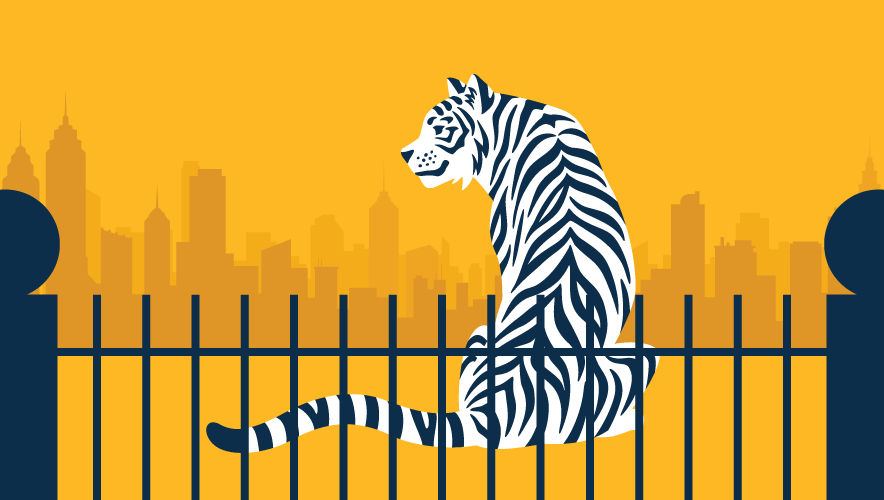How Zoos Respond When a Dangerous Animal Escapes
Who doesn’t love a little walk on the river’s edge? It’s a chance to explore, feel the sun on your face, and see what’s on the other side of your Saint Louis Zoo enclosure.
Those thoughts were all presumably going through Andean bear Ben’s head on 7 February 2023 when he meddled with the steel mesh of his outdoor habitat, causing a cable to give way and allowing him to work his way out to explore the greater River’s Edge section of the zoo.
The zoo initiated its Animal Emergency Response protocol, ultimately securing Ben’s habitat, tranquilizing him, and safely returning him to an indoor holding area, according to a press release.
After his great escape, the zoo upped Ben’s security—adding stainless steel cargo clips rated at 450 pounds tensile strength. But it wasn’t enough to contain him. Ben managed to escape again on 23 February, prompting a shelter-in-place order at the zoo while staff responded, tranquilizing Ben and moving him to a secure area.
The escapes prompted zoo officials to meet with advisory groups and ultimately decide to relocate Ben to a habitat where he would thrive—and be less likely to escape.
“Together, the group agrees that it is in Ben’s best interest to transfer him to the Gladys Porter Zoo in Brownsville, Texas,” according to a press release from the Saint Louis Zoo. “The Gladys Porter Zoo is an Association of Zoos and Aquariums accredited zoo with a long history of working with Andean bears. Their Andean bear habitat includes a moat rather than steel mesh outdoor habitat, which the group believes would be a more ideal environment for Ben.”
While Ben’s breakout attempts were endearing to the public, they also highlight the need for zoos to have trained teams to respond should an Andean bear or a more lethal predator escape their enclosure, posing a potential threat to human life, or should someone intentionally or accidentally enter an animal’s enclosure.
Security Requirements
Zoos accredited through the Association of Zoos and Aquariums (AZA) are required to secure their animal exhibits and holding areas to prevent animal escapes. Zoos also must have barriers in place (guardrails, fences, walls, etc.) of “sufficient strength” or design to “deter public entry into animal exhibits and other sensitive areas that pose a risk to animal or human safety,” according to the AZA’s 2024 Accreditation Standards and Related Practices.
For zoos with potentially dangerous animals in their collections—such as elephants, lions, tigers, or gorillas—they are required to have additional safety procedures in place to prevent attacks or injuries. This includes adequate security systems, security personnel trained to handle emergencies, firearms, and personnel authorized to use those firearms.
“Stored firearms must be in a locked cabinet of sufficient construction and design to impede unauthorized entry, and located in a secure area and accessible only to authorized personnel trained in their use,” the AZA guide explains. “Personnel authorized to utilize firearms must have adequate training on safe operation and must practice on a regular basis to safely operate the weapons during an emergency response.”
In more practical terms, this means that AZA accredited zoos have teams trained to respond with up to lethal force should a dangerous animal escape its enclosure and threaten human life.
In 2007 at the Denver Zoo, for instance, a jaguar attacked a zookeeper in its enclosure. The zoo’s emergency response team, known as the Ranger Team, took action to attempt to save the employee.
Leslie Chenaille, director of public safety and emergency management at the Denver Zoological Foundation, says the zoo offered counseling for the staff team because of the traumatic loss of the zookeeper and the jaguar.
This experience means that the Denver Zoo takes its Ranger Team responsibilities seriously “because we’ve seen the outcome,” Chenaille adds. “And we know other institutions who have had situations, whether an animal getting out or a person getting in, and it makes you realize the risk is really there. We take it very seriously.”
Creating the Team
Zoos are unique institutions. Each has a different approach to designating the teams that respond to a dangerous animal escape or a human intruder into an enclosure.
At the Denver Zoo, this team is called the Ranger Team and is made up of about 20 staff members who have volunteered for the additional job responsibility, says Heather Genter, behavioral husbandry manager, Denver Zoological Foundation, and head of the Ranger Team.
Genter took over responsibility for the team roughly six years ago and created a more formal process for joining the team—including an interview to discuss past history with weapons, familiarity with the zoo’s facilities, and the ability to put a human life above an animal’s life in case of an emergency.
“Past experience can be super beneficial,” Genter says. “Most of my rangers are some sort of recreational hunter or have experience with target practice. I’m also looking for their experience and knowledge of the campus we’re working at.”
Chenaille adds that opening the Ranger Team membership to individuals beyond animal care staff is helpful because those team members might have less of an emotional attachment to the animals.
“There’s a little less connection. Not to say that our master electrician doesn’t love our animals, but he’d have less of an emotional connection, and it would be easier, psychologically, to pull the trigger if he had to,” she says. “It also opens it up to people who have weapons experience. There are fewer people who have that experience and may be comfortable at that level. It’s one thing to hunt a goose; it’s very different to see an elephant at the other end.”
After the interview, prospective team members must meet several requirements to ultimately join the Ranger Team, including reviewing written material, watching training videos, visiting a firing range with different team members, executing a dry fire (a practice exercise where an individual fires a gun without ammunition), and passing a final written exam.
“They’re required to complete a dry fire so many times a year, go out to the range to shoot our weapons—shoot skeet to make sure they can hit moving targets,” Genter adds. “They also have to constantly stay up-to-date with our classification of animals, perimeter fencing, and buildings, as well as emergency drills.”
As an AZA accredited zoo, Denver is required to conduct at least four emergency drills per year. Chenaille says they regularly complete more than that and typically design them in-house to test situations that are applicable to the zoo and its animal collections.
For instance, the zoo ran a drill for how the Ranger Team would respond if a person fell into the moat in the bear exhibit at the zoo. This involved securing the bears and coordinating with the local fire department to extract the person from the water feature.
Denver also runs drills for new animals coming in that might have a history of unpredictable behavior, such as a new gorilla, to walk through what that behavior looks like and how the team would respond to different scenarios.
At the Columbus Zoo, on the other hand, the team is called the Special Response Team (SRT), says Steven Langton, director of safety and security at the Columbus Zoo Family of Parks. The team is made up of three individuals who have firearms or lengthy experience with the animals at the Columbus Zoo, as well as the entire security team—approximately 20 staff members.
SRT membership is a key component of the job that Langton says is discussed during the recruitment and interview process for a security team position. Being on the SRT is “a big responsibility, having to be able to take that shot—if need be—especially in a high-stress situation,” he adds.
He looks for individuals who have strong decision-making skills because if the SRT is deployed, everyone on the team has the authority to make the call whether to take a shot.
“That’s putting a lot of responsibility in somebody’s hands—especially when you’re talking about animals that everybody knows and loves, and the potential for a bunch of guests to be around in high-stress situations,” Langton says. “Their decision-making, whether or not a shot is necessary, is critical to making sure that we get it right every time if we are ever put into that position.”
Having firearms experience is not a requirement to be hired as a member of the security team because the zoo will train individuals as part of their onboarding process.
“Sometimes it’s easier to train somebody who doesn’t have any experience because they don’t have bad habits you have to break,” Langton adds. “It’s easier to start them at a base level and get them comfortable with the weapons, get comfortable with our drills and scenarios before making them a full part of the team.”
The three non-security SRT staff members are individuals with a strong combination of weapons skills and animal history background, who have experience and understand the animals in the collection well.
Langton says that this team regularly trains together to be prepared to respond to incidents at the zoo.
“Training is something we take really seriously because when you are involving people with weapons, especially in a public setting or with potentially thousands of guests around, weapon safety is of the utmost importance,” he explains. “We go to the range and train four to six times a year. Then we also do classroom training.”
The range time is key to keeping members’ weapons proficiency high while ensuring that everyone remains comfortable with the weapons that the SRT is using and must qualify on twice per year: Remington 870 shotguns and SIG 716is rifles. The SRT is also trained to use a .375 H&H, a large caliber rifle, which would be used for engaging elephants, rhinos, and other extremely large animals.
The Columbus Zoo SRT uses the local county sheriff’s office firing range to run drills and its qualification course, as well as to test accuracy.
“Because if we do have to engage an animal, we want to take it down as quickly and humanely as possible,” Langton explains. “Accuracy is of utmost importance, but we build in things like running in a time requirement to help build up that stress and adrenaline while knowing that nothing’s going to simulate what you’re going to feel if you had to do it for real.”
The Columbus property is vast—nearly 600 acres in total—so being able to move quickly across an area is important. Endurance, clear communication, weapons safety, and muzzle awareness are all key components of training scenarios at the range, along with responding to weapons malfunctions so if an SRT member engages an animal and their weapon jams they know how to recover quickly to continue the response.
Training also provides time to work through scenarios and familiarize team members with various facets of the nearly 100-year-old campus.
“We work with our animal care team to have access to those buildings when there aren’t animals in there so that we can look and see how doors function, which ways they open, how the locks work in those buildings,” Langton says. “If we ever have to go in under a stressful situation, we have a good idea of how all that works.”
Off the range, Langton says that the SRT works to build trust with the animal care team by interacting with them regularly. When a bear or tiger is moved to the zoo’s hospital for an exam, for instance, the SRT participates in the movement and will sometimes be present for the actual exam.
“If they’re in a hospital room with a dangerous animal, we’re standing right there beside them,” Langton says. “That goes a long way for just getting them comfortable with not just us but having somebody with a weapon in their presence because sometimes that’s new to people.”
It also provides SRT members with an opportunity to understand the animals better, how they might move, react to certain situations, and what is or is not threatening behavior. The Columbus Zoo has been using this process for about six years and the interaction has helped build stronger relationships and communication between team members.
“If something were to happen for real, there shouldn’t be surprises as far as how we communicate and how we get along with each other,” Langton adds.
At the Denver Zoo, working with the animal care and veterinary teams are also key components for the Ranger Team.
Genter explains that animal care staff are trained to respond to animal emergencies, barricading public areas to make sure guests are removed from the situation, bringing in emergency equipment, and attempting to recall animals back to their area.
Veterinary staff are trained to respond at the same time, bringing their equipment to the scene to assist with recalling the animal or shooting it with a tranquilizer dart to sedate it for recovery. One of the issues with using a tranquilizer, however, is that there is no guarantee how effective it will immediately be, Chenaille adds.
“You don’t know how long that tranquilizer is going to take,” she says. “That’s where the choice is going to have to be made—you’ll need time and you might not have enough medicine.”
In Action
So, what does this look like in action? Say one of the Columbus Zoo’s Amur tigers—males weigh more than 500 pounds and stretch 10 feet in length—were to escape its enclosure. A zoo staff member would report that the tiger is out of its exhibit, which would initiate alerts to lock down the zoo. Employees who are not part of the SRT would be responsible for getting themselves and guests they come across to safety, such as inside a building or vehicle that can be locked.
Meanwhile, the SRT would deploy to its weapons lockers throughout the zoo to retrieve weapons and protective vests before making their way to the last known area that the tiger was spotted. The first SRT member to make it to the scene is designated as the lead and is responsible for notifying the incident commander that they have that role.
A representative from the zoo’s animal care team would then meet up with the SRT lead and be designated as the Capture Team Lead. This individual is ideally someone who knows the tiger, is familiar with his instincts and mannerisms, and can help the SRT decide if the animal can be captured. The zoo’s veterinarian staff also plays a role in this process, helping the SRT determine if they can use a tranquilizer dart to subdue the animal instead of using lethal force.
“Once all these team leads get on site, they are going to talk and come up with a plan of action to enact to capture this animal as safely and humanely as possible,” Langton says.
But if it’s an instance where the tiger is loose and has attacked someone, posing a threat to human life, then the SRT lead is authorized to immediately take the shot to save people.
“That’s why decision-making is important. That’s why they have the authority to do it, because we’re not going to hesitate and have somebody potentially be killed if [SRT] have the capability to end that situation before that happens,” Langton says.
The zoo uses a similar process for responding to incidents of a human gaining unauthorized entrance to an animal’s enclosure, including locking down the zoo. This ensures that access lanes for emergency vehicles and team members are open to respond quickly.
“Then depending on the enclosure, we have pre-identified vantage points where we’re going to go to different areas around the yard,” Langton says. “So that no matter where that person is inside the yard, we would hopefully have a way to view them, see what they’re doing, and see how the animals are reacting.”
In these scenarios, the animal care team can play a critical role because all the zoo’s animals are trained to recall—to move to a certain location or area when they hear a certain noise or see a certain signal. So, if someone gets into the tiger yard, the animal keepers will attempt to recall the tigers.
“Whether or not they’re going to recall, it’s hard to say,” Langton says. “If they take an interest in somebody who’s clearly not supposed to be in their space, then the recall may not be successful.”
The zoo will make efforts to get the person out of the enclosure, but should the tiger move to threaten that human’s life, then the SRT would have the authority to shoot the tiger to save that person.
In both an animal escape and a human intrusion, Columbus Zoo will notify law enforcement. Police, fire, and EMS personnel will stage in the zoo’s parking lot to respond to any injuries and assist with recovery from animal escapes. These outside departments would only take an active role in responding to the escape if the animal managed to leave zoo property, Langton says.
In situations where someone enters an animal exhibit, first responders will enter the zoo grounds. The zoo may need assistance from the local fire department to extract the person from a moat or other security obstacle or provide medical assistance if that person is injured.
The Denver Zoo follows a similar response pattern that the Columbus Zoo does. If a dangerous animal escapes its enclosure, a “Code Red” would be called over the radio and initiate the Ranger Team response.
Members of the team would deploy to their weapons cabinets, unlock them, and retrieve firearms and ammo packs. The team would also pick up a radio handler—someone who can run the radio communications and drive a vehicle to take the Ranger Team member to the scene.
Ideally the radio handler is also a member of the Ranger Team, but it can be any employee at the zoo because all staff members are trained in how to respond to these types of emergencies and are tested in drills multiple times per year.
“In most situations, we can resolve it without using firearms—a lot of times we’re able to herd the animal,” Genter says.
After an incident, or a drill, there are meetings to discuss what went well and what needs to be improved upon. Genter adds that sometimes this brings up mechanical issues that impeded response times.
“That might result in a work order so we find other ways of dealing with emergencies—safer ways—and we practice as much as we can to make sure we all know what we’re doing and the best way to do it,” she says.
Safeguarding the Weapons Team
After a response concludes, the Columbus Zoo will take measures to preserve the privacy of the SRT members who responded. This is because staffers might be shamed on social media or be subject to death threats for making what outsiders perceive to be the wrong choice, says Langton, referring to the aftermath at the Cincinnati Zoo following its response to the Harambe incident. In May 2016, young boy entered a male silverback gorilla’s enclosure, initiating a response that ended with zoo staffers killing the gorilla to save the boy’s life—sparking debate and outrage online.
“We don’t want to subject anybody on our team to that—for their safety, for the safety of their families,” he says. Staff are instructed not to use the name of the team member who fired a shot while responding to an emergency over the radio afterwards. The SRT also has protocols in place to have that team member move to a safe location and secure the firearm that was used in case it needs to be examined by law enforcement.
The team member, along with additional zoo staff, would also be provided with information about the employee assistance program, as well as counseling support. The Columbus Zoo has also signed up for services with Growing Resiliency for Aquarium and Zoo Employees (GRAZE), which provides mental health support to zoo and aquarium staff members.
Genter adds that the Denver Zoo also relies heavily on its HR department when handling the emotional stress that comes with deploying the Ranger Team and responding to an emergency.
“Our HR team has lots of different resources for places for people who can help us cope, should we need to,” she says. “We’ve employed that before, and it was very helpful to have those outside places to talk through these things.”
Creating a Dialogue
During the past several years, many zoos have become more open about their emergency response protocols—including teams like the SRT and Ranger Team. Langton says this shift is due in part to the work of the AZA Safety Committee, which has been getting people together to share best practices and lessons learned.
Specialized training for these teams is also helping to standardize these teams and increase understanding of why they exist. After taking over the Ranger Team, Genter says she interviewed several companies and ultimately worked with local firm, Bristle Cone, to create course content that is applicable for zoo emergency response teams.
“They were fantastic and really catered the course to what we needed,” she adds. “They created a class that served as the foundation for new shooters, with basic safety and skills. And each year we meet again for skill building.”
The Columbus Zoo recently participated in a training day with Tactical Firearms Academy, a company based in Florida that provides zoo-specific weapons training programs.
It held a demonstration day with zoos to spend the day at the firing range, going through drills and methodology to explain how to respond quickly and humanely.
“Across the board through all the different zoos’ shooting teams, it’s the same mindset and methodology that we deploy in a situation—to not have to take the shots,” Langton says. “We’re going to figure out any type of workaround that we can, until it comes time where we have to save a human life or have to stop that animal getting off of zoo grounds. It’s necessitated for us. Other than that, taking a shot is never our goal.”
Genter says that being a member of one of these teams is a huge responsibility, and that she is proud of staff members who voluntarily join the Ranger Team.
“It’s a big decision to make in their careers—to be put potentially in a very dangerous situation. They really care about the safety of the staff, the guests, and the animals in the zoo,” she says. “And taking that on, it means a lot to me that they volunteer for this responsibility and potentially putting themselves in situations that are really risky.”
Megan Gates is senior editor at Security Management. Connect with her at [email protected] or on LinkedIn. Follow her on X or Threads: @mgngates.











